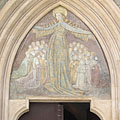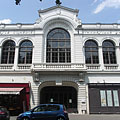(Optimalizované pre zariadenia s malou obrazovkou)
Miscellaneous photos - Ráckeve, Maďarsko
Po kliknutí:
Kliknutím na obrázky!
-

The Art Nouveau (secessionist) style Town Hall (the building includes the City Court as well)
This Alföld-style Art Nouveau town hall was built in 1901 during one single year, the contractor was a certian Lemberger company (probably the company of Alfréd Lemberger master builder from Budapest). The building has a medieval cellar, which is remain from the previous town hall.
Dátum fotenie: 7.7.20112011
Vytvoril: Robert Németh
Model fotoaparátu: Konica Minolta Dimage A200
Ráckeve, Maďarsko
-
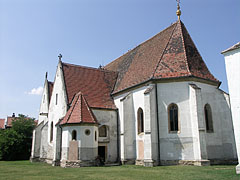
Serbian Kovin Monastery (Serbian Orthodox Church and Monastery, dedicated to the Dormition of Mother of God)
Dátum fotenie: 7.7.20112011
Vytvoril: Robert Németh
Model fotoaparátu: Konica Minolta Dimage A200
Ráckeve, Maďarsko
-

The western facade of Savoy Mansion, viewed from the garden
The mansion was built between 1702-1750 for Prince Eugene of Savoy, architect: Johann Lukas von Hildebrandt.
Dátum fotenie: 7.7.20112011
Vytvoril: Robert Németh
Model fotoaparátu: Konica Minolta Dimage A200
Ráckeve, Maďarsko
-
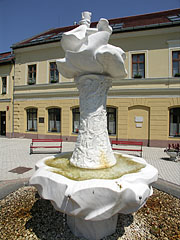
The white marble János Vitéz Fountain or John the Vailant's Fountain
The sculpture created by György Markolt in 1999.
Dátum fotenie: 7.7.20112011
Vytvoril: Robert Németh
Model fotoaparátu: Konica Minolta Dimage A200
Ráckeve, Maďarsko
-

Small stone memorial- and lookout tower over the ruins of a former medieval church
It was built in the 1970s.
Dátum fotenie: 7.7.20112011
Vytvoril: Robert Németh
Model fotoaparátu: Konica Minolta Dimage A200
Ráckeve, Maďarsko
-

The tower of the Town Hall (clock tower, fire-watch tower and lookout tower in one)
Dátum fotenie: 7.7.20112011
Vytvoril: Robert Németh
Model fotoaparátu: Konica Minolta Dimage A200
Ráckeve, Maďarsko
-
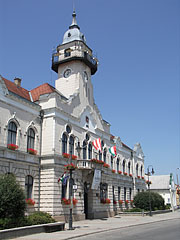
Town Hall (or City Hall) of Ráckeve
Dátum fotenie: 7.7.20112011
Vytvoril: Robert Németh
Model fotoaparátu: Konica Minolta Dimage A200
Ráckeve, Maďarsko
-

Town Hall of Ráckeve
Dátum fotenie: 7.7.20112011
Vytvoril: Robert Németh
Model fotoaparátu: Konica Minolta Dimage A200
Ráckeve, Maďarsko
-
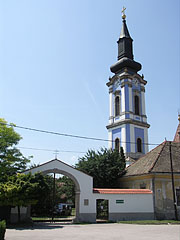
Wall and gate of the so-called "Serbian Croft" or "Serbian Yard" (in Hungarian "Szerb Porta"), and the blue tower of the Serbian Orthodox Church and Monastery
Dátum fotenie: 7.7.20112011
Vytvoril: Robert Németh
Model fotoaparátu: Konica Minolta Dimage A200
Ráckeve, Maďarsko
-

The blue steeple (tower) of the Serbian Orthodox church
Dátum fotenie: 7.7.20112011
Vytvoril: Robert Németh
Model fotoaparátu: Konica Minolta Dimage A200
Ráckeve, Maďarsko
-
Facade of the Town Hall with the main door and a balcony over it
Dátum fotenie: 7.7.20112011
Vytvoril: Robert Németh
Model fotoaparátu: Konica Minolta Dimage A200
Ráckeve, Maďarsko
Facade of the Town Hall with the main door and a balcony over it - Ráckeve, Maďarsko -
A wooden memorial column to commemorate the heroes of the Hungarian Revolution in 1956, and some distance away the blue Árpád Bridge can be seen
The memorial column was created by Sándor Sófalvi.
Dátum fotenie: 7.7.20112011
Vytvoril: Robert Németh
Model fotoaparátu: Konica Minolta Dimage A200
Ráckeve, Maďarsko
A wooden memorial column to commemorate the heroes of the Hungarian Revolution in 1956, and some distance away the blue Árpád Bridge can be seen - Ráckeve, Maďarsko -
Árpád Bridge of Ráckeve
Dátum fotenie: 7.7.20112011
Vytvoril: Robert Németh
Model fotoaparátu: Konica Minolta Dimage A200
Ráckeve, Maďarsko
Árpád Bridge of Ráckeve - Ráckeve, Maďarsko -
World War I Memorial
It was created in 1931
Dátum fotenie: 7.7.20112011
Vytvoril: Robert Németh
Model fotoaparátu: Konica Minolta Dimage A200
Ráckeve, Maďarsko
World War I Memorial - Ráckeve, Maďarsko -
Bronze statues of two soldiers on the World War I. Memorial
Dátum fotenie: 7.7.20112011
Vytvoril: Robert Németh
Model fotoaparátu: Konica Minolta Dimage A200
Ráckeve, Maďarsko
Bronze statues of two soldiers on the World War I. Memorial - Ráckeve, Maďarsko -
Neo-baroque style former bridge toll house
It was built in 1932, architect: Artúr Sebestyén
Dátum fotenie: 7.7.20112011
Vytvoril: Robert Németh
Model fotoaparátu: Konica Minolta Dimage A200
Ráckeve, Maďarsko
Neo-baroque style former bridge toll house - Ráckeve, Maďarsko -
Municipal Picture Gallery
Dátum fotenie: 7.7.20112011
Vytvoril: Robert Németh
Model fotoaparátu: Konica Minolta Dimage A200
Ráckeve, Maďarsko
Municipal Picture Gallery - Ráckeve, Maďarsko -
Stone tower at the road on the way to Kiskunlacháza, at the border of Ráckeve town and the Pereg Forest Park
Dátum fotenie: 7.7.20112011
Vytvoril: Robert Németh
Model fotoaparátu: Konica Minolta Dimage A200
Ráckeve, Maďarsko
Stone tower at the road on the way to Kiskunlacháza, at the border of Ráckeve town and the Pereg Forest Park - Ráckeve, Maďarsko -
Looking towards the main road from the small stone tower at the eastern border of Ráckeve town
Dátum fotenie: 7.7.20112011
Vytvoril: Robert Németh
Model fotoaparátu: Konica Minolta Dimage A200
Ráckeve, Maďarsko
Looking towards the main road from the small stone tower at the eastern border of Ráckeve town - Ráckeve, Maďarsko -
Entering into the Csepel Island from the Árpád Bridge of Ráckeve (the former customs house or toll house is on the right, and a restaurant is ahead)
Dátum fotenie: 7.7.20112011
Vytvoril: Robert Németh
Model fotoaparátu: Konica Minolta Dimage A200
Ráckeve, Maďarsko
Entering into the Csepel Island from the Árpád Bridge of Ráckeve (the former customs house or toll house is on the right, and a restaurant is ahead) - Ráckeve, Maďarsko -
Contour of the historical Great Hungary (Kingdom of Hungary) and its coat of arms, made of flowers
Dátum fotenie: 7.7.20112011
Vytvoril: Robert Németh
Model fotoaparátu: Konica Minolta Dimage A200
Ráckeve, Maďarsko
Contour of the historical Great Hungary (Kingdom of Hungary) and its coat of arms, made of flowers - Ráckeve, Maďarsko -
World War I. memorial
Dátum fotenie: 7.7.20112011
Vytvoril: Robert Németh
Model fotoaparátu: Konica Minolta Dimage A200
Ráckeve, Maďarsko
World War I. memorial - Ráckeve, Maďarsko -
The former toll house of the Árpád Bridge of Ráckeve
Dátum fotenie: 7.7.20112011
Vytvoril: Robert Németh
Model fotoaparátu: Konica Minolta Dimage A200
Ráckeve, Maďarsko
The former toll house of the Árpád Bridge of Ráckeve - Ráckeve, Maďarsko -
Coat of arms of Hungary made of flowers, at the beginning of the Árpád Bridge
Dátum fotenie: 7.7.20112011
Vytvoril: Robert Németh
Model fotoaparátu: Konica Minolta Dimage A200
Ráckeve, Maďarsko
Coat of arms of Hungary made of flowers, at the beginning of the Árpád Bridge - Ráckeve, Maďarsko -
Neo-gothic Reformed Church (designed by József Dobrovszky, based on another Reformed Church in Tiszakécske)
Dátum fotenie: 7.7.20112011
Vytvoril: Robert Németh
Model fotoaparátu: Konica Minolta Dimage A200
Ráckeve, Maďarsko
Neo-gothic Reformed Church (designed by József Dobrovszky, based on another Reformed Church in Tiszakécske) - Ráckeve, Maďarsko -
János vitéz Fountain or Sir John's Fountain at the Roman Catholic Church
Created by György Markolt in 1999
Dátum fotenie: 7.7.20112011
Vytvoril: Robert Németh
Model fotoaparátu: Konica Minolta Dimage A200
Ráckeve, Maďarsko
János vitéz Fountain or Sir John's Fountain at the Roman Catholic Church - Ráckeve, Maďarsko -
Interior of the Roman Catholic Church of St. John the Baptist
The church was built between 1791-1799.
Dátum fotenie: 7.7.20112011
Vytvoril: Robert Németh
Model fotoaparátu: Konica Minolta Dimage A200
Ráckeve, Maďarsko
Interior of the Roman Catholic Church of St. John the Baptist - Ráckeve, Maďarsko -
Old crucifix at the Roman Catholic church
According to the inscription it was created in 1897.
Dátum fotenie: 7.7.20112011
Vytvoril: Robert Németh
Model fotoaparátu: Konica Minolta Dimage A200
Ráckeve, Maďarsko
Old crucifix at the Roman Catholic church - Ráckeve, Maďarsko -
The János Vitéz Fountain and the yellow-painted St. Emeric (Szent Imre) Catholic Primary School in the square
Dátum fotenie: 7.7.20112011
Vytvoril: Robert Németh
Model fotoaparátu: Konica Minolta Dimage A200
Ráckeve, Maďarsko
The János Vitéz Fountain and the yellow-painted St. Emeric (Szent Imre) Catholic Primary School in the square - Ráckeve, Maďarsko -
János Vitéz Fountain or John the Vailant's Fountain
The white marble sculpture was created by György Markolt in 1999.
Dátum fotenie: 7.7.20112011
Vytvoril: Robert Németh
Model fotoaparátu: Konica Minolta Dimage A200
Ráckeve, Maďarsko
János Vitéz Fountain or John the Vailant's Fountain - Ráckeve, Maďarsko -
The Szent Imre (St. Emeric) Catholic Primary School and the Roman Catholic Church of St. John the Baptist
Dátum fotenie: 7.7.20112011
Vytvoril: Robert Németh
Model fotoaparátu: Konica Minolta Dimage A200
Ráckeve, Maďarsko
The Szent Imre (St. Emeric) Catholic Primary School and the Roman Catholic Church of St. John the Baptist - Ráckeve, Maďarsko -
Church of the Reformed Congregation of Ráckeve
It was built in 1913, its tower is 43 meters high.
Dátum fotenie: 7.7.20112011
Vytvoril: Robert Németh
Model fotoaparátu: Konica Minolta Dimage A200
Ráckeve, Maďarsko
Church of the Reformed Congregation of Ráckeve - Ráckeve, Maďarsko -
Reformed Church of Ráckeve
Dátum fotenie: 7.7.20112011
Vytvoril: Robert Németh
Model fotoaparátu: Konica Minolta Dimage A200
Ráckeve, Maďarsko
Reformed Church of Ráckeve - Ráckeve, Maďarsko -
The former State Civil School (at the time of photography Árpád Fejedelem Primary School)
And from 2012 onwards it is the Máté Skarica Public Library.
Dátum fotenie: 7.7.20112011
Vytvoril: Robert Németh
Model fotoaparátu: Konica Minolta Dimage A200
Ráckeve, Maďarsko
The former State Civil School (at the time of photography Árpád Fejedelem Primary School) - Ráckeve, Maďarsko -
The southern wall of the Town Hall
Dátum fotenie: 7.7.20112011
Vytvoril: Robert Németh
Model fotoaparátu: Konica Minolta Dimage A200
Ráckeve, Maďarsko
The southern wall of the Town Hall - Ráckeve, Maďarsko -
Serbian Kovin Monastery (Serbian Orthodox Church and Monastery of Ráckeve, dedicated to the Dormition of Mother of God)
Dátum fotenie: 7.7.20112011
Vytvoril: Robert Németh
Model fotoaparátu: Konica Minolta Dimage A200
Ráckeve, Maďarsko
Serbian Kovin Monastery (Serbian Orthodox Church and Monastery of Ráckeve, dedicated to the Dormition of Mother of God) - Ráckeve, Maďarsko -
The Serbian Kovin Monastery and Orthodox Church is one of the oldest monasteries in Hungary
Dátum fotenie: 7.7.20112011
Vytvoril: Robert Németh
Model fotoaparátu: Konica Minolta Dimage A200
Ráckeve, Maďarsko
The Serbian Kovin Monastery and Orthodox Church is one of the oldest monasteries in Hungary - Ráckeve, Maďarsko -
The separated bell tower of the Serbian Ortodox Church
Dátum fotenie: 7.7.20112011
Vytvoril: Robert Németh
Model fotoaparátu: Konica Minolta Dimage A200
Ráckeve, Maďarsko
The separated bell tower of the Serbian Ortodox Church - Ráckeve, Maďarsko -
The small rockery or rock garden of the Serbian Orthodox Monastery
Dátum fotenie: 7.7.20112011
Vytvoril: Robert Németh
Model fotoaparátu: Konica Minolta Dimage A200
Ráckeve, Maďarsko
The small rockery or rock garden of the Serbian Orthodox Monastery - Ráckeve, Maďarsko -
The isolated blue-white baroque style belfry (bell tower) of the Serbian Kovin Monastery (Serbian Orthodox Church and Monastery, dedicated to the Dormition of Mother of God)
Dátum fotenie: 7.7.20112011
Vytvoril: Robert Németh
Model fotoaparátu: Konica Minolta Dimage A200
Ráckeve, Maďarsko
The isolated blue-white baroque style belfry (bell tower) of the Serbian Kovin Monastery (Serbian Orthodox Church and Monastery, dedicated to the Dormition of Mother of God) - Ráckeve, Maďarsko -
Red marble gravestone in the wall of the Serbian Orthodox Church
Dátum fotenie: 7.7.20112011
Vytvoril: Robert Németh
Model fotoaparátu: Konica Minolta Dimage A200
Ráckeve, Maďarsko
Red marble gravestone in the wall of the Serbian Orthodox Church - Ráckeve, Maďarsko -
The vaulted stone gate of a restaurant in the yellow building (Cadran Pub & Pizzeria)
Dátum fotenie: 7.7.20112011
Vytvoril: Robert Németh
Model fotoaparátu: Konica Minolta Dimage A200
Ráckeve, Maďarsko
The vaulted stone gate of a restaurant in the yellow building (Cadran Pub & Pizzeria) - Ráckeve, Maďarsko -
A crooked old building, the former Radovich House (nowadays Cadran Pub & Pizzéria)
Dátum fotenie: 7.7.20112011
Vytvoril: Robert Németh
Model fotoaparátu: Konica Minolta Dimage A200
Ráckeve, Maďarsko
A crooked old building, the former Radovich House (nowadays Cadran Pub & Pizzéria) - Ráckeve, Maďarsko -
"Earth and sky", an aluminum statue of a male figure on the wall of the Municipal Picture Gallery (in Hungarian "Városi Képtár")
The 370-centimeter-tall statue was created by Antal Bodzán in 1997.
Dátum fotenie: 7.7.20112011
Vytvoril: Robert Németh
Model fotoaparátu: Konica Minolta Dimage A200
Ráckeve, Maďarsko
"Earth and sky", an aluminum statue of a male figure on the wall of the Municipal Picture Gallery (in Hungarian "Városi Képtár") - Ráckeve, Maďarsko -
The four-star Kék Duna Wellness Hotel (the Hungarian word "Kék Duna" means "Blue Danube")
Dátum fotenie: 7.7.20112011
Vytvoril: Robert Németh
Model fotoaparátu: Konica Minolta Dimage A200
Ráckeve, Maďarsko
The four-star Kék Duna Wellness Hotel (the Hungarian word "Kék Duna" means "Blue Danube") - Ráckeve, Maďarsko -
Colorful Art Nouveau (secession style) dwelling houses
Dátum fotenie: 7.7.20112011
Vytvoril: Robert Németh
Model fotoaparátu: Konica Minolta Dimage A200
Ráckeve, Maďarsko
Colorful Art Nouveau (secession style) dwelling houses - Ráckeve, Maďarsko -
Classy dwelling house
Dátum fotenie: 7.7.20112011
Vytvoril: Robert Németh
Model fotoaparátu: Konica Minolta Dimage A200
Ráckeve, Maďarsko
Classy dwelling house - Ráckeve, Maďarsko -
Nice dwelling houses
Dátum fotenie: 7.7.20112011
Vytvoril: Robert Németh
Model fotoaparátu: Konica Minolta Dimage A200
Ráckeve, Maďarsko
Nice dwelling houses - Ráckeve, Maďarsko -
The Savoy Mansion or Savoyai Mansion was the first baroque style secular castle in Hungary
Built between 1702 and 1750
Dátum fotenie: 7.7.20112011
Vytvoril: Robert Németh
Model fotoaparátu: Konica Minolta Dimage A200
Ráckeve, Maďarsko
The Savoy Mansion or Savoyai Mansion was the first baroque style secular castle in Hungary - Ráckeve, Maďarsko -
Bronze statue of Árpád Grand Prince of the Hungarians on the top of a column
It was inaugurated in 1897, during the Hungarian Millenium ceremonies (the 1000th anniversary of the existence of Hungary)
Dátum fotenie: 7.7.20112011
Vytvoril: Robert Németh
Model fotoaparátu: Konica Minolta Dimage A200
Ráckeve, Maďarsko
Bronze statue of Árpád Grand Prince of the Hungarians on the top of a column - Ráckeve, Maďarsko -
Statue of Árpád Grand Prince of the Hungarians
Created by Gyula Szász, inaugurated in 1897.
Dátum fotenie: 7.7.20112011
Vytvoril: Robert Németh
Model fotoaparátu: Konica Minolta Dimage A200
Ráckeve, Maďarsko
Statue of Árpád Grand Prince of the Hungarians - Ráckeve, Maďarsko -
Coat of arms of Árpád Grand Prince of the Hungarians, on the column of the Árpád Statue
Dátum fotenie: 7.7.20112011
Vytvoril: Robert Németh
Model fotoaparátu: Konica Minolta Dimage A200
Ráckeve, Maďarsko
Coat of arms of Árpád Grand Prince of the Hungarians, on the column of the Árpád Statue - Ráckeve, Maďarsko -
Statue on the stone gate of the Savoy Mansion
Dátum fotenie: 7.7.20112011
Vytvoril: Robert Németh
Model fotoaparátu: Konica Minolta Dimage A200
Ráckeve, Maďarsko
Statue on the stone gate of the Savoy Mansion - Ráckeve, Maďarsko -
The main facade of the baroque Savoy Mansion (or Ráckeve Palace)
Dátum fotenie: 7.7.20112011
Vytvoril: Robert Németh
Model fotoaparátu: Konica Minolta Dimage A200
Ráckeve, Maďarsko
The main facade of the baroque Savoy Mansion (or Ráckeve Palace) - Ráckeve, Maďarsko -
Savoyai Mansion (also known as Ráckeve Palace or incorrectly Savoy Castle)
Dátum fotenie: 7.7.20112011
Vytvoril: Robert Németh
Model fotoaparátu: Konica Minolta Dimage A200
Ráckeve, Maďarsko
Savoyai Mansion (also known as Ráckeve Palace or incorrectly Savoy Castle) - Ráckeve, Maďarsko -
The lobby of the Savoyai Mansion (currently it is a palace hotel)
Dátum fotenie: 7.7.20112011
Vytvoril: Robert Németh
Model fotoaparátu: Konica Minolta Dimage A200
Ráckeve, Maďarsko
The lobby of the Savoyai Mansion (currently it is a palace hotel) - Ráckeve, Maďarsko -
Savoy Palace, corridor in the mansion hotel
Dátum fotenie: 7.7.20112011
Vytvoril: Robert Németh
Model fotoaparátu: Konica Minolta Dimage A200
Ráckeve, Maďarsko
Savoy Palace, corridor in the mansion hotel - Ráckeve, Maďarsko -
The main gate of the Savoyai Mansion
Dátum fotenie: 7.7.20112011
Vytvoril: Robert Németh
Model fotoaparátu: Konica Minolta Dimage A200
Ráckeve, Maďarsko
The main gate of the Savoyai Mansion - Ráckeve, Maďarsko -
The west facade of the 18th-century baroque Savoy Mansion, viewed from the garden
Dátum fotenie: 7.7.20112011
Vytvoril: Robert Németh
Model fotoaparátu: Konica Minolta Dimage A200
Ráckeve, Maďarsko
The west facade of the 18th-century baroque Savoy Mansion, viewed from the garden - Ráckeve, Maďarsko -
Savoyai Mansion, park with a pond
Dátum fotenie: 7.7.20112011
Vytvoril: Robert Németh
Model fotoaparátu: Konica Minolta Dimage A200
Ráckeve, Maďarsko
Savoyai Mansion, park with a pond - Ráckeve, Maďarsko
Kliknutím na obrázky!
Charakteristiky, vlastnosti, rysy
Poloha:
GPS súradnice: Šířka 47°10'10", Dĺžka 18°56'39" (N47 10.17 - E18 56.65)
Informácie, krátke poviedky, zaujímavé fakty
 Stone tower at the road on the way to Kiskunlacháza, at the border of Ráckeve town and the Pereg Forest Park
Stone tower at the road on the way to Kiskunlacháza, at the border of Ráckeve town and the Pereg Forest Park
The 12-hectare Pereg Forest Nature Reserve (in Hungarian "Peregi Parkerdő") at the eastern edge of Ráckeve town belongs to the Danube-Ipoly National Park, it begins near the road to Kiskunlacháza. The location has both valuable natural and cultural treasures, this is why it is protected. The traditional denominations of the area, which is situated on a smaller hill: "Pusztatemplom" (literally "Puszta Church") or "Templomhát dűlő". There was a small village here in the Middle Ages, which was called Pereg or Berek. Due to the frequent threat of flooding and the harassment of the Turks the inhabitants "moved the whole village" to Kiskunlacháza. For today Pereg became a district of Kiskunlacháza town. It is easy to find the protected forest, because at the edge of it there's a small stone "tower", which is clearly visible from the road.
It's quite hard to figure out what this building should be, because there is no any caption on it (at least nowadays). Many sources even refer to it as an ancient Roman watchtower, but the reality is somewhat more prosaic. The in the surroundings of the current stone tower there were archaeological excavations in the 1960s and 1970s. Wall remains of a medieval church and burial places came to light on the spot. The tower was built onto the ruins of this church, using the stones of it as well. So the structure is a small lookout tower and memorial monument in one.
 Small stone memorial- and lookout tower over the ruins of a former medieval church
Small stone memorial- and lookout tower over the ruins of a former medieval church
It was built in the 1970s.
The planting of trees and other plant species into the protected Pereg Forest near Ráckeve was started after the archaeological excavations in the late-1970s, and still going on today. Among others there are notable special sweet chestnut and larch collection, as well as the insect and bird life here is also noteworthy.
There's a grassy meadow around the stone tower that was built upon the wall remains of a medieval church. Every year usually on 10th of May this is the location of the "Day of Birds and Trees" (in Hungarian "Madarak és Fák Napja") event. This national tradition has quite old history.
In 1902 the international community entered into an agreement to protect the useful birds. In the same year the Hungarian ornithologist István Chernel organized the first "Day of Birds and Trees" (or "Birds' and Trees' Day") in Hungary. Probably it was directly based on the American "Birds Day" and "Arbor Day" events.
Four years later Count dr. Albert Apponyi de Nagyappony who was at that time the Minister of Religion and Education of Hungary (and later in 1920 after the World War I he was the leader of the Hungarian delegation to the Versailles Peace Conference in the Grand Trianon Palace in Paris, France) issued a regulation for the schools to organize this event in May or June every year, to teach morality and love of nature.
Although its significance was decreased after the First World War, in 1931 Count Kuno von Klebelsberg Minister of Education included it again into an educational regulation, probably also out of respect for Count Albert Apponyi. After the Second World War during the many decades of the socialism in Hungary it was pushed into the background again, but since the political system change of Hungary in 1989 it plays an important role in child rearing again.
 Interior of the Roman Catholic Church of St. John the Baptist
Interior of the Roman Catholic Church of St. John the Baptist
The church was built between 1791-1799.
The walls and the ceiling inside the Roman Catholic Church of St. John the Baptist of Ráckeve are covered with large murals, wall paintings. However, these are not fresco, but so-called secco (or fresco-secco) paintings, and to top it all the largest ones in Europe (640 square meters of contiguous painting). The difference lies in the method of painting. In case of a fresco dry powdered paint is applied to wet surface, the painting virtually becomes part of the plaster. However, in case of secco technique everything is the opposite, the painter is working with dry surface and wet paint. Of course for a layman's eye it is hard to determine the making technique of a finished artwork, so most of the people often call the large murals simply frescos.
The secco-technique murals of the Roman Catholic Church of Ráckeve were created by the Munkácsy Awarded local painter László Patay in 1994.
 János Vitéz Fountain or John the Vailant's Fountain
János Vitéz Fountain or John the Vailant's Fountain
The white marble sculpture was created by György Markolt in 1999.
The "János Vitéz" ("John the Valiant") epic poem is one of the best works of the Hungarian poet Sándor Petőfi. The main character in this poetic tale is supposedly inspired by the story of a real person, a serf who was born in Ráckeve and became a cavalry (hussar) captain, he was called János Horváth Nepomuk (or Nepomuki). According to this theory the real "John the Valiant" was born as János Piringer in 1774, his mother widowed early and then married with János Horváth royal tax-collector, and the child received the name of his new father. But soon his mother went to heaven, his stepfather was often drunken, squandered his wealth and left him alone. The orphan boy was then adopted by his uncle György Piringer, who was a miller in a watermill and had a daughter called Juliska ("Juliet").
In 1793 a war began to break out against the French Revolution and the Jacobins, so Ráckeve had to send three rookie hussar soldiers (cavalrymen) to Francis I Emperor of Austria and King of Hungary. János Horváth N. was a bushelman and tailor's assistant, and for the 12 years of military service in the 1st Hussar Regiment the tailors' guild chose him to send. He already felt an affection for Juliska, so he left her reluctantly, with a heavy heart.
He and his regiment went to Northern Italy, where he learned more languages. In the Napoleonic times he was moved to the 5th Hussar Regiment (the "Radeczky Regiment"), and two years later in 1800 during the first Battle of Marengo he defended General Alvinczy with his own body. He was seriously wounded, but later he was honored for this heroism.
 The white marble János Vitéz Fountain or John the Vailant's Fountain
The white marble János Vitéz Fountain or John the Vailant's Fountain
The sculpture created by György Markolt in 1999.
The true story of the real "János Vitéz", who inspired the main character in the poetic tale of the Hungarian poet Sándor Petőfi now continues.
When from 1808 the relationship between Pope Pius VII and Napoléon Bonaparte deteriorated, the Pope was exiled to Switzerland and he regained their rights again only in 1814. On the way which led through the Alps he was accompanied by the cavalry squadron of János Horváth N. hussar captain, who in the cold allegedly draped his cloak over the old Pope (this scene also can be seen on a wall painting in the corridor of the Vatican library). In his audience the Pope awarded the captain who became the knight of the Supreme Order of Christ (in Italian "Ordine Supremo del Cristo") and the Order of St. George (founded in Hungary, in Hungarian "Szent György Vitézei Lovagrend").
After 22 years of military service he was demobilized when he was 41 years old, but when he returned to Ráckeve his lover Juliska already married with someone else, so just close friendship remained between them. Some times later he served in the Royal Guards as a chief captain, and after 11 years in 1835 he returned to his homeland again, settled down and died here in 1847 (his grave is also here in Ráckeve).
So that's how the beautiful tale was born from the not less interesting reality, and also that's why there is János Vitéz ("John the Vailant") fountain in a square of Ráckeve. Otherwise the Hungarian poet Sándor Petőfi personally never been in Ráckeve. The "János Vitéz" epic poem was written by Petőfi in 1844, probably Károly Ács, a law student from Ráckeve told him the base story of it in 1843. Károly Ács was introduced to Petőfi by his friend Mór Jókai Hungarian writer in Kecskemét.
 Serbian Kovin Monastery (Serbian Orthodox Church and Monastery, dedicated to the Dormition of Mother of God)
Serbian Kovin Monastery (Serbian Orthodox Church and Monastery, dedicated to the Dormition of Mother of God)
Today the Serbian Kovin Church an Monastery in Ráckeve (Serbian Kovin = Српски Ковин = Ráckeve) is the only surviving gothic style orthodox church in Hungary, all the rest were demolished by the Turks between the 16th to 18th centuries. However, this church didn't escape the war without being damaged, in the World War II it was hit by a bomb. But miraculously the bomb did not explode so the losses were much smaller.
 Serbian Kovin Monastery (Serbian Orthodox Church and Monastery of Ráckeve, dedicated to the Dormition of Mother of God)
Serbian Kovin Monastery (Serbian Orthodox Church and Monastery of Ráckeve, dedicated to the Dormition of Mother of God)
The Ráckeve Monastery (or Serbian Kovin Monastery Church) one of the oldest religious institutions of this type. It was founded probably in the first half of the 12th century by the Serbian-born Queen Helena or Ilona, wife of King Béla II of Hungary (Béla the Blind) in Ábrahámtelke settlement, which was on the place of the present-day Ráckeve. Later, in 1440 King Ulászló I of Hungary (Władysław III of Poland) donated land and a 13th-century church to the Serbian-Hungarian people who were fleeing from the Turks. In fact, this is the date of the founding of the Ráckeve (or Felsőkeve) town. The 13th-century early gothic style single-nave church had thick freestone walls.
The gothic nave of the present church was consecrated in 1487, and the bell tower received its current baroque form in 1756. The renaissance style side chapels (the St. John's Chapel and the Chapel of St. Cosmas and Damian) were built later, in the 16th century. The church interior is covered with gothic net vault (or rib vault) roof, as well as the walls are covered with Balkan or Byzantine style murals everywhere.
 The Serbian Kovin Monastery and Orthodox Church is one of the oldest monasteries in Hungary
The Serbian Kovin Monastery and Orthodox Church is one of the oldest monasteries in Hungary
The murals in the Serbian Orthodox Monastery Church of Ráckeve received their current appearance after the older ones were painted over by Teodor Simeonov from Voskopoja (today Moscopole, Albania) between 1765-1771. On some parts of the wall also the earlier frescos appear again under the newer paintings, these were created in 1514. The four main panels of the iconostasis were created in 1746, the other icons in 1770.
It cannot be overlooked that the sources are quite contradictory concerning the followings:
1. Was the present-day church a completely new building when it was consecrated, or was it just the rebuilt old church which was formerly donated by King Ulászló I of Hungary in 1440?
2. The foundations and the lowest two levels of the tower are sometimes mentioned as created in the 16th century, but other sources say in the late-13th century or even in the 11th century (so let's face it, it does matter when).
The argument that the church was built much earlier then the often mentioned 1487 is supported among others with an information board inside the building. This says that the murals were repainted three times over the centuries, and the first date was 1320. Moreover, if the building would be built in 1487 already as an orthodox church, probably nobody would want to make the mural painter's job more difficult with the gothic walls and ceiling which are divided into sections, as it can be seen today.
Today the Serbian Orthodox Church of Ráckeve (Serbian Kovin) is mostly monument, museum and attraction (however it's a pity that for some reason taking photos is prohibited indoors, and also there's no option to buy photographers' ticket, at least in 2011). According to the 2001 census there are only 64 Greek Catholics in the town, so the church is full of orthodox believers (who come here from other parts of Hungary) only once a year, on the 29th of August.
 The separated bell tower of the Serbian Ortodox Church
The separated bell tower of the Serbian Ortodox Church
It is clearly visible that the upper part of the belfry in the so-called "Serbian Croft" (in Hungarian "Szerb Porta") in Ráckeve differs from its lower part, where the walls are even 2.5 meters in thickness. These walls were probably built together with the late-13th-century gothic single-nave church, or maybe even earlier, in the 11th century. The old tower had elongated pyramid-shaped spire and allegedly reached the 50 meters in height.
It is uncommon among the Serbian baroque churches that the bell tower stands separately from the church, here it is probably due to the construction on old foundations.
The present blue-white painted bell tower was built on the old foundations in 1756, probably after the former gothic belfry collapsed. The height of the current tower is about 40 meters, including the copperplate-covered ornate spire (although other sources say it is just 34 meters in height).
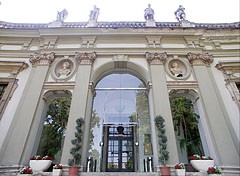 The main facade of the baroque Savoy Mansion (or Ráckeve Palace)
The main facade of the baroque Savoy Mansion (or Ráckeve Palace)
The Savoyai Mansion of Ráckeve was badly damaged in the World War II, and in the following decades its condition continued to deteriorate. The renovation of the state-owned palace was begun in 1975 and in fact it is still going on today. Today there is a restaurant and a 30-room mansion hotel within the building. Among other things the "Zimmer Feri 2." Hungarian comedy movie was filmed here in 2010.
Ráckeve - Ďalšie fotogalérie:
Tiež by vás mohlo zaujímať (Súvisiace stránky):
Destinácie v cestovnom sprievodcu:
Ráckeve (92 fotky)
Pest megye (county) (15 122 fotky + 50 panoramatické zábery)
Budapešť a jeho okolie (15 989 fotky + 52 panoramatické zábery)
Maďarsko (27 287 fotky + 163 panoramatické zábery)
a okrem toho:
(v rámci tu: Pest megye)
Pilis Mountains (Pilis hegység) (335 fotky)
Buda Hills (Budai-hegység) (8 632 fotky + 21 panoramatické zábery)
Gödöllő Hills (Gödöllői-dombság) (4 203 fotky + 21 panoramatické zábery)
Cegléd (125 fotky + 2 panoramatické zábery)
Dunakeszi (259 fotky)
Göd (23 fotky)
Nagykőrös (250 fotky + 2 panoramatické zábery)
Nagymaros (31 fotky)
Pilisvörösvár (88 fotky)
Szentendre (597 fotky + 1 panoramatické zábery)
Vác (232 fotky + 2 panoramatické zábery)
Visegrád (220 fotky + 1 panoramatické zábery)
Csővár (105 fotky)
Kóspallag (53 fotky)
Márianosztra (37 fotky)
Nagybörzsöny (4 fotky)
Pilisszentkereszt (122 fotky)
Zsámbék
Každá panoramatické fotografie tu:
Ráckeve ( fotky)
Pest megye (county) (50 fotky)
Budapešť a jeho okolie (52 fotky)
Maďarsko (163 fotky)
Európa (165 fotky)
Každý normálny foto tu:
Ráckeve (92 fotky / 2 galéria)
Pest megye (county) (15 122 fotky / 221 galéria)
Budapešť a jeho okolie (15 989 fotky / 234 galéria)
Maďarsko (27 287 fotky / 462 galéria)
Európa (30 494 fotky / 523 galéria)
https://www.panadea.com/sk/guidebook/rackeve/photos/gal-002

Pridať k Obľúbeným Pridať k Záložkám
Zdieľajte so svojimi priateľmi!
atď.
Náš cestovný sprievodca obsahuje:
Početné fotky a panoramatické obrázky, s množstvom informácií a zaujímavých faktov.
- 214 turistické destinácie
- 165 panoramatické zábery
- 30 494 ďalšie fotografie
Veľká zbierka vybraných fotografií: výborná kvalita, vysoké rozlíšenie a prirodzené farby
Všetky práva vyhradené
- ©2010-2022
Neuronit Creative Studio - Mogyoród / Budapešť / Maďarsko




